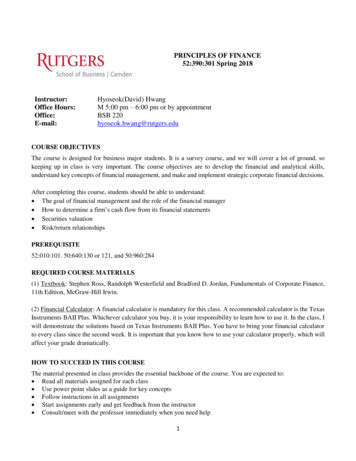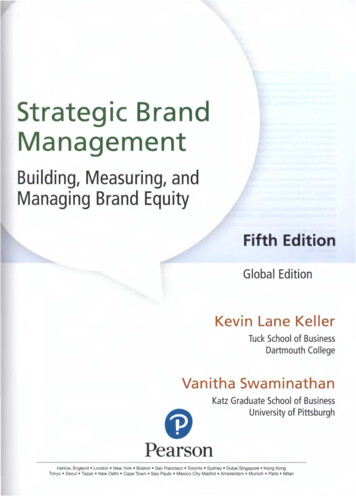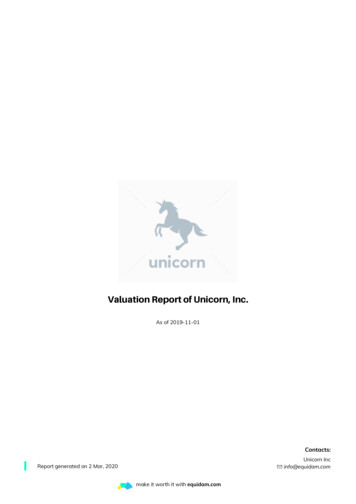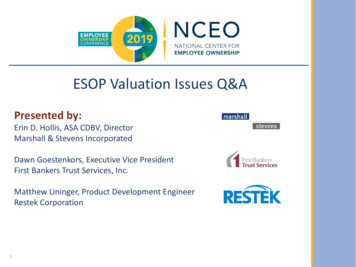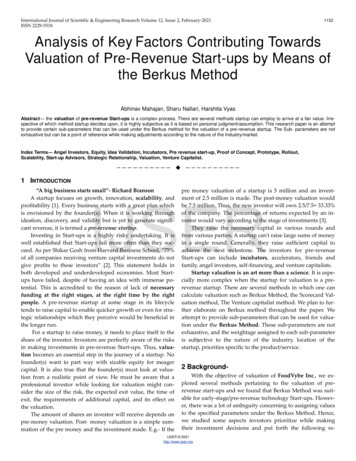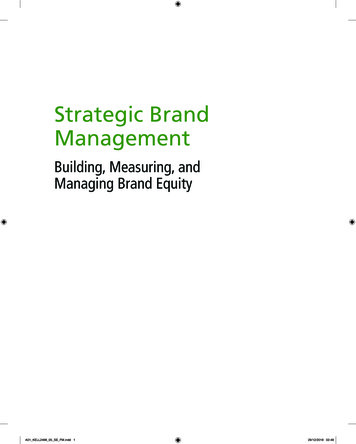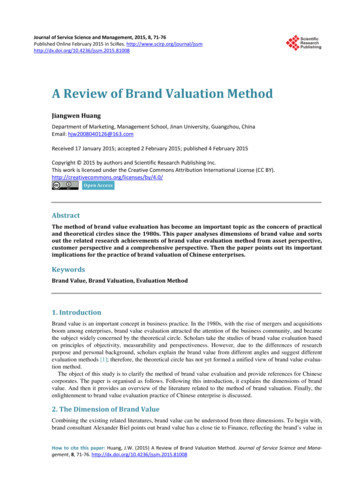
Transcription
Journal of Service Science and Management, 2015, 8, 71-76Published Online February 2015 in SciRes. /10.4236/jssm.2015.81008A Review of Brand Valuation MethodJiangwen HuangDepartment of Marketing, Management School, Jinan University, Guangzhou, ChinaEmail: hjw2008040126@163.comReceived 17 January 2015; accepted 2 February 2015; published 4 February 2015Copyright 2015 by authors and Scientific Research Publishing Inc.This work is licensed under the Creative Commons Attribution International License (CC tractThe method of brand value evaluation has become an important topic as the concern of practicaland theoretical circles since the 1980s. This paper analyses dimensions of brand value and sortsout the related research achievements of brand value evaluation method from asset perspective,customer perspective and a comprehensive perspective. Then the paper points out its importantimplications for the practice of brand valuation of Chinese enterprises.KeywordsBrand Value, Brand Valuation, Evaluation Method1. IntroductionBrand value is an important concept in business practice. In the 1980s, with the rise of mergers and acquisitionsboom among enterprises, brand value evaluation attracted the attention of the business community, and becamethe subject widely concerned by the theoretical circle. Scholars take the studies of brand value evaluation basedon principles of objectivity, measurability and perspectiveness. However, due to the differences of researchpurpose and personal background, scholars explain the brand value from different angles and suggest differentevaluation methods [1]; therefore, the theoretical circle has not yet formed a unified view of brand value evaluation method.The object of this study is to clarify the method of brand value evaluation and provide references for Chinesecorporates. The paper is organised as follows. Following this introduction, it explains the dimensions of brandvalue. And then it provides an overview of the literature related to the method of brand valuation. Finally, theenlightenment to brand value evaluation practice of Chinese enterprise is discussed.2. The Dimension of Brand ValueCombining the existing related literatures, brand value can be understood from three dimensions. To begin with,brand consultant Alexander Biel points out brand value has a close tie to Finance, reflecting the brand’s value inHow to cite this paper: Huang, J.W. (2015) A Review of Brand Valuation Method. Journal of Service Science and Management, 8, 71-76. http://dx.doi.org/10.4236/jssm.2015.81008
J. W. Huangthe financial. Esteban-Bravo and Lado [2] indicated that brand value is the added value of brand in the financial.Hence, brand value is the cash flow brought to products or services by brand. On this basis, the CEO of UK Interbrand company Michael Birkin said, similar to other economic assets value, brand value reflects the presentvalue of all the equity in the future [3]. Therefore, brand value can be interpreted as the financial benefit for enterprise created by brand as an asset.Secondly, consulting firm Market Facts considered brand value is whether people continue to buy the brand’sproduct or service, which means brand value has a very close relationship with customer’s brand loyalty [4]. TheBrand Value Committee agreed with this point of view, noting that brand value is a unique commitment to thecustomer providing by brand, which is worthy to own and trust [5]. According to this, brand value can be understood from the perspective of the customer. The stronger the relationship between the customer and the brand,the higher brand value.Thirdly, some scholars defined brand value from a comprehensive perspective including both the asset andcustomer. Brand pioneer Donizlaff pointed out that brand value are those factors when the customer contacts thebrand image, to some extent, that have an impact on customer’s positive and negative values, and these factorshave a significant economic value [6]. Zhang et al. [7] showed that brand value comes from the asset value aswell as the customer value. From the above analysis, brand value evaluation can be carried out based on threeperspectives: asset-based perspective, customer-based perspective, and a combination of asset and customerbased perspective. These three kinds of evaluation methods focus on different points.3. The Method of Brand Valuation3.1. Brand Value Evaluation Based on Asset PerspectiveBrand asset value is the foundation of brand value evaluation [8]. Specifically, it’s to quantify the value of brandasset from the perspective of corporate finance, which means brand value is reflected in the financial benefitsobtained by companies from the brand [9]. Based on this, Liu [10] indicated that the market share, excess profits,brand protection, trends and market characteristics as well as the ability of internationalization of the brand areelements that brand valuation must include, and other value elements not related to brand asset can’t be contained. So when using a certain method for brand valuation, a major difficulty is to distinguish the benefit ofbrand asset from that of corporate’s other intangible assets. Only stripping out the real contribution created bybrand asset, does brand value avoid being overestimated.There are many brand valuation methods with quantitative indicators under the asset perspective, in which theInterbrand method and the Financial World method show greatest impact. Fu [11] argued that the Interbrandmethod has a basic assumption: brand value is reflected to ensure that brand owners can get a more stable income in the future. Thus, it is necessary to assess brand value on the basis of the company’s future earningsthrough financial analysis, market analysis and brand analysis. First, use financial analysis to evaluate the residual earnings of a product or a business, which refers to the balance of the future income from the product orbusiness minus the revenue from the tangible assets. Second, clear the impact of brand on the industry of theproduct or service through market analysis, thus determining how many percentages of residual earnings arecreated by the brand, so as to calculate the brand’s future earnings. Third, take the analysis from ten areas including authenticity, clarity, brand commitment, brand protection, adaptability, consistency, diversity, visibility,relevance and understandability to determine the coefficient of brand strength, then convert the brand strengthcoefficient to the discount rate of brand’s future earnings through an S-shaped curve [11] (the discount rate isused when discounting brand future earnings for the current yield). According to this idea, brand value is calculated as: brand value future earnings of brand brand strength. On the basis of inheriting the advantages of theInterbrand method, the Financial World method develops its own characteristic with the expert assessing brandmarket performance to obtain the data of brand’s earnings. Assessment is first built on the company’s sales. Theexpert judges the average profit margin of industry according to his experience, and calculates the company’soperating profit, from which excludes profits that have nothing to do with the brand, in order to get the data ofpure profit created by brand. Next, calculate the brand strength coefficient using the Interbrand method. Finally,calculate the brand value with the formula as follows: brand value brand net profit brand strength.3.2. Brand Value Evaluation Based on Customer PerspectiveBrand Valuation under the perspective of customers, is to measure the brand’s status in their hearts from the de-72
J. W. Huanggree of such aspects as their familiarity with the brand, perception of the brand quality, and association of thebrand, etc. Yu and Zhao [12] believed that customers are the foundation of brand value, and argued that brandvalue is “the differential response of customers to enterprise marketing activities in the aspects of cognition,emotion, and behavior intention and behavior”. On this basis, Kim and Kim [13] pointed out that customerbased brand valuation must consider three factors: brand loyalty, perceived quality and brand image. Wang [14]thought besides the joint action of brand loyalty and brand awareness, brand valuation needs to consider the influence of whether the customer to buy on the real value of brand. Researches under customers’ perspectiveprovide a basis for the quantitative assessment of brand value.Brand valuation methods based on the customer perspective with quantitative indicators include the premiummethod and the loyalty factor method. The principle of the premium method is that by calculating how high anextra price customers are willing to pay when buying a particular brand of product or service to determine thesize of the brand value. It includes the following three steps. First of all, through the market research to confirmthe price of overflow, namely the extra price that customers are willing to pay for the purchase of a brandedgoods or services compared with buying a non-branded product or service. And then calculate the excess profitby multiplying the price with the current sales of the branded product or service. Finally, get the brand valuewith the excess profits divided by the industry’s average profit margin of the branded product or service, whichis calculated as follows: brand value the premium sales/average profit margin. On the basis of considerationof the premium as well as sales of a branded product or service, Fan and Leng [15] added the element of customer loyalty to further improve the brand valuation method. They believed that brand value embodies in thatthe brand can increase corporate benefits in the future, which depends on a broad customer loyalty. To this end,they used the “loyalty factor” to represent the proportion of customers deciding to start buying or repeat buyingthe branded product in the future to all the target customers, with the help of the customer’s brand loyalty andbrand attractiveness to assess the brand value. The calculation formula is: brand value theoretical target customer base loyalty factor cycle purchases (unit product price unit unbranded product price) numbersof cycle within the time limit.3.3. Brand Value Evaluation Based on a Comprehensive PerspectiveBrand value evaluation based on a comprehensive perspective exhibits establishing the link between brand assetand customers, considering the value brought to the enterprise and the customer at the same time by the brand.Hence, Yoo and Donthu [16] pointed out that brand asset value based on the customer can be measured throughthree dimensions including brand loyalty, perceived quality and brand awareness/association. Washburn andPlank [17] built the evaluation scale of brand equity value from the view of the customer. In addition, He andZhao [18] found that brand value assessment can be carried out by three factors seven dimensions, in whichthese three factors are common factor, basic common factor and special factor. Common factor includes fourdimensions: brand loyalty, brand image, entrepreneur image and brand support. Basic common factor includestwo dimensions: brand innovation and brand tenacity, and special factor includes a dimension reflecting the industry. In summary, these results enrich the study of brand valuation method under the comprehensive perspective.More well-known brand valuation methods based on a comprehensive perspective include the ten elementsmodel of brand equity and the model of customer-based brand equity. Aaker believes, brand value is “a group ofassets and liabilities associated with the name and symbol of a brand, which can increase or reduce the value tothe company or the customer caused by a product or services”, and takes five specific dimensions 10 indicators(that is, ten elements) for brand valuation (as shown in Table 1). The brand value under this model is calculatedas: brand value (price advantage satisfaction/loyalty) (perceived quality leading brand/popularity) (perceived value brand personality organization association) brand awareness (market prices and distribution channels market share). In the same period when Aaker proposed the ten elements model of brand equity, Keller also put forward another influential method of brand valuation. The core of this approach is how tomeasure brand equity value from the customer level, referred to as CBBE model (as shown in Figure 1). Amongthem, the significance means the extent of difficulty and the frequency that the brand can be identified in a variety of situations by the customer. The performance and image are used to measure the degree of customer’sperception of brand connotation from the specific (functional) and abstract angle respectively. The evaluationand perception measure the extent of customer’s reflexion of the brand, the former of which refers to the customer’s view of the brand, and the latter is perceptual behavior of the customer to the brand, such as enthusiasm,73
J. W. HuangTable 1. Brand equity ten elements.Core dimensionsEvaluation factorsPrice advantageBrand loyaltySatisfaction/loyaltyPerceived qualityBrand perceptionLeading brand/popularityPerceived valueBrand associationBrand personalityOrganization associationBrand awarenessBrand awarenessMarket prices and distribution channelsBrand market situationMarket shareThe chart source: according to the relevant literature review.Figure 1. CBBE model. The chart source: according to the reference drawn in this paper.self-esteem. The resonance is to measure the strength of the relationship between the customer and the brand.Therefore, the brand value under the CBBE model is calculated as: brand value brand significance (brandperformance brand image) (brand evaluation brand feeling) brand resonance.4. The Enlightenment to Brand Value Evaluation Practice of Chinese EnterpriseIn the past few years, brand valuation practice of Chinese enterprise has got some developments. However, it isstill in its infancy, and there are many urgent problems need to consider when applying the above methods. Inthe first place, the government-led “famous brand” assessment activities have appeared in the reality. In order tomake their own corporate brands rank well, candidates often bribe related personnel who are responsible forbrand valuation work, causing the evaluation results to loss their objectivity. In addition, although brand valuation can be carried through based on asset perspective, customer perspective and a comprehensive perspective,these methods under each perspective are not applicable to all types of brands. Their scopes of application areshown in Table 2.74
J. W. HuangTable 2. Various brand value evaluation methods.DimensionMethod nameCalculation expressionScope of applicationBrand value future earningsof brand brand strengthBe used in any product category orbrand, especially in such marketbehaviors as brand acquisitions,mergers or leasing [20]. However,when the range of product’s brandradiation is narrow, it does not work.The FinancialWorld methodBrand value brand netprofit brand strengthBe used in any product category orbrand, especially in such marketbehaviors as brand acquisitions,mergers or leasing [20]. However,when the range of product’s brandradiation is narrow, it does not work.The premiummethodBrand value the premium sales/average profit marginMore suitable for products that thecustomer is relatively familiar with.The loyaltyfactor methodBrand value theoretical target customerbase loyalty factor cycle purchases (unitproduct price unit unbranded product price) numbers of cycle within the time limitFor products frequently purchased, butnot for consumer durables with a longperiod to repeat shopping [15].The ten elementsmodel of brand equityBrand value (price advantage satisfaction/loyalty) (perceived quality leading brand/popularity) (perceived value brandpersonality organization association) brandawareness (market prices and distributionchannels market share)Not only for researches of continuity,but also for customised research;for a specific industry, appropriateadjustments are made for indicatorsto better adapt to the characteristicsof the industry [20].The CBBE modelBrand value brand significance (brandperformance brand image) (brandevaluation brand feeling) brand resonanceMore suitable for products that thecustomer is relatively familiar with.The Interbrand methodBased on assetperspectiveBased oncustomerperspectiveBased on acomprehensiveperspectiveThe chart source: according to the relevant literature review.Moreover, each brand valuation method is more or less flawed. Lu Juan [19] argued that congenital deficiencies exists in brand valuation, and no matter what kind of method is used to assess brand value, the result couldonly guarantee relatively reasonable but not absolute accurate. Therefore, it demands a rational view of brandvaluation methods under different perspectives. To begin with, evaluation methods from the asset perspectivequantify the value of the brand with financial indicators, such as brand revenues or brand profits, which are notonly in line with the principle of measurability of valuation, but also to facilitate their applications in practice.However, they ignore the impact of customers on brand value. More importantly, they do not take the specialnature of Chinese enterprise market into account. At present, the enterprise market in China has not yet achievedthe situation of full competition, individual industry even gives its priority to monopolistic market, resulting inthe flow of profits between industries is uneven. The Interbrand method, while trying to use the “brand effectindex” to account for differences in the role of brands in different industries, but “brand effect index” is subjective [11], thus fails to objectively reflect the fact of Chinese enterprise market.Brand value evaluation from customers’ perspective, helps businesses obtain more real data of brand value,and clears the source of each part of value. However, brand value assessment must consider the case of brandcreating value in the future, which is principle of perspectiveness. The corporate assesses brand value throughthe perspective of customers, the resulting data from which to a large extent only reflects the value of the brandat this stage. The loyalty factor method tries to consider profitability cases of the brand in the future using the“loyalty factor”, but due to the uncertainty between the purchase intention and the actual purchase behavior, aswell as the possibility and quantity of purchase for different customers being not the same [15], this method alsojust gets data of the brand value at present.Finally, brand valuation method of an integrated perspective, like the ten elements model of brand equity,gains the result of a comprehensive and close to the fact when assessing the brand value. It takes these factorsinto account from both the brand asset level, such as brand’s market share, and the customer level, such as customer’s satisfaction or loyalty to the brand. However, because it involves too many measurement indexes, thusincreasing the difficulty of its usage in practice. Comprehensive analysis, the government should involve as less75
J. W. Huangas possible or even withdraw from the field of brand valuation, so that it can be carried out in accordance withthe market mechanism. Meanwhile, when taking brand valuation, Chinese enterprises should choose a more appropriate method to obtain an objective and accurate evaluation result according to their own industry characteristics.5. ConclusionThis paper explains the specific meaning of brand value, which is reflected in the brand asset value, the relationship value between the customer and the brand and the comprehensive value of both the asset and the customer. On this basis, it sorts out the relevant literature on brand valuation method from a different perspective,and proposes several enlightenments for brand valuation practices of Chinese enterprises. It can be said, this article provides an idea to solve the problem that there isn’t a unified point of view on the method of brand valueevaluation in the theoretical circle. Moreover, since the mergers and acquisitions between different brands are invogue at present, how to evaluate the brand value objectively and comprehensively is a problem of the industry.This article takes brand valuation based on asset perspective, customer perspective, and a comprehensive perspective, to make a very good response for this problem.References[1]Yoo, B., Donthu, N. and Lee, S. (2000) An Examination of Selected Marketing Mix Elements and Brand Equity.Journal of the Academy of Marketing Science, 28, 195-211. an-Bravo, M. and Lado, N. (2011) Brand Value in Horizontal Alliances: The Case of Twin-Cars. Journal of theOperational Research Society, 62, 1533-1542. http://dx.doi.org/10.1057/jors.2010.112[3]Tom, C., Tim K. and Jack, M. (1999) Valuation. Encyclopedia of China Press, Beijing.[4]Keller, K.L. (1993) Conceptualizing, Measuring, and Managing Customer-Based Brand Equity. The Journal of Marketing, 57, 1-22. http://dx.doi.org/10.2307/1252054[5]Keller, K.L., Heckler, S.E. and Houston, M.J. (1998) The Effects of Brand Name Suggestiveness on Advertising Recall.The Journal of Marketing, 61, 48-57. http://dx.doi.org/10.2307/1251802[6]Paul, S.B. and Yin, Y. (2000) The Power of the Brand. CITIC Press, Beijing.[7]Zhang, Y., Zhang, R. and Liu, J.P. (2010) Review on Sources and Its Theories of Brand Value. Forecasting, 29, 74-80.[8]Goldfarb, A., Lu, Q. and Moorthy, S. (2009) Measuring Brand Value in an Equilibrium Framework. Marketing Science,28, 69-86. , D.E. and Schultz, H.F. (2003) Brand Babble: Sense and Nonsense about Branding. South-Western Educational Pub, Cincinnati Ohio.[10] Liu, E.K. (1997) Talk about the Corporate Brand Evaluation Methods from the Elements of Brand Value. EconomicForum, 1, 17-19.[11] Fu, G.Q. (1999) A Review of Brand Valuation Method of Interbrand. Foreign Economics & Management, 37-41.[12] Yu, C.L. and Zhao, P. (2003) Brand Asset and the Interpretation of the Related Concentsin Evaluating This Brand Asset. Nankai Business Review, 10-13.[13] Kim, H.-B. and Kim, W.G. (2005) The Relationship between Brand Equity and Firms’ Performance in Luxury Hotelsand Chain Restaurants. Tourism Management, 26, 549-560. ] Wang, J.F. (2004) A Research in Brand Value. Economic Survey, 120-122.[15] Fan, X.C. and Leng, Y. (2000) The Loyalty Factor Method of Brand Valuation. Scientific Management Research, 18,50-56.[16] Yoo, B. and Donthu, N. (2001) Developing and Validating a Multidimensional Consumer-Based Brand Equity Scale.Journal of Business Research, 52, 1-14. ] Washburn, J.H. and Plank, R.E. (2002) Measuring Brand Equity: An Evaluation of a Consumer-Based Brand EquityScale. Journal of Marketing Theory and Practice, 10, 46-61.[18] He, Z.Y. and Zhao, Z.B. (2005) Research on the Common Factors of Consumer-Based Brand Equity. Finance andEconomics, 75-80.[19] Lu, J. (2001) A Review of Brand Equity Valuation Method. Statistical Research, 34-37.[20] Lu, T.H. (2002) Measurement of Brand Equity: Pattern and Perspective. Journal of Sun Yatsen University (SocialScience Edition), 44, 88-97.76
Brand asset value is the foundation of brand value evaluation [8]. Specifically, it's to quantify the value of brand asset from the perspective of corporate finance which means brand value is reflected in the financial benefits , obtained by companies from the brand [9]. Based on this, Liu [10] indicated that the market share, excess profits,
